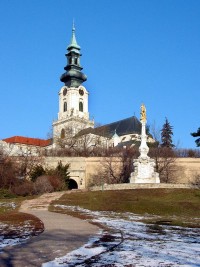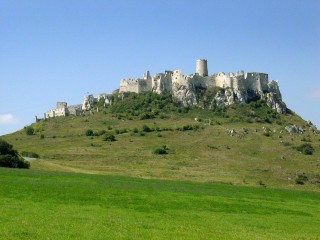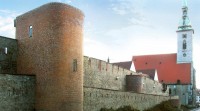The kingdom of Hungary
Following the fall of Great Moravia, the nomadic Magyars became the new power in Europe. After their defeat on the Lech River they were forced to abandon their nomadic and rapacious ways; they settled in the centre of the Carpathian valley, adopted Christianity and began to build a new state – the Hungarian kingdom.
 István (Stephen), from the Árpád family, became their first king in 1000. The new state assimilated a number of traditions from Great Moravia and from the Danube Slavs (Slovaks). Numerous Slovak words in the Hungarian language from those areas of life which the Magyars were at the time oblivious or only mildly aware of – from agriculture, public administration and religious life to crafts and urbanism - are proof of this. The early multi-ethnic Hungary was a tolerant state. Ethnic tensions were restrained by the unifying influence of Christianity, the dominant use of Latin and the fact that the feudal lords of Slovak origin once belonged to the power elites.
István (Stephen), from the Árpád family, became their first king in 1000. The new state assimilated a number of traditions from Great Moravia and from the Danube Slavs (Slovaks). Numerous Slovak words in the Hungarian language from those areas of life which the Magyars were at the time oblivious or only mildly aware of – from agriculture, public administration and religious life to crafts and urbanism - are proof of this. The early multi-ethnic Hungary was a tolerant state. Ethnic tensions were restrained by the unifying influence of Christianity, the dominant use of Latin and the fact that the feudal lords of Slovak origin once belonged to the power elites.
During the 11th century, present-day Slovakia enjoyed special status within the framework of Hungary. A border apanage duchy ruled by the Árpád princes, mostly the younger brothers of the king, was situated here. They had their seat in Nitra where they minted their own coins and had their own army. At the beginning of the 12th century this duchy declined. From that time right up to 1918, Slovakia was directly a part of Hungary.
The first centuries of Hungary were turbulent; peace was fragile and cruel fights for royal power were frequent. On the other hand an administration was established and churches and monasteries were built (especially by the Benedictines) with the first libraries. Hungary had its first local saints in around 1083 – King Stephen and the monks Svorad and Benedict, whose monastic life and work was connected with Nitra and Skalka near Trenčín.
In 1222 the position of the Hungarian aristocracy was significantly strengthened when King András II (Andrew II, 1205-1235) granted them significant privileges and power-sharing concessions.
During the reign of Béla IV (1235-1279) Hungarian nobles were granted substantial tracts of land in exchange for military support, leading to the development of sizeable baronial estates. Thereafter the aristocracy emerged as Hungary's most powerful political force, unique in their size (more than 5 per cent of the population), self-esteem and pride.
During this period revolutionary changes took place in Hungary, especially after the destructive Tatar (Mongol) invasions of 1241-1242. Stone castles were built in the more mountainous areas; up to 200 of them were constructed in what is now Slovakia, and today Spiš Castle is the largest castle ruin in Central Europe. Subsequently, in an effort to develop the local economy, the Hungarian kings established fortified castle towns, offering financial incentives to artisans and merchants to settle in them. Colonists came from Germany, Italy and further afield, helping to improve mining, building, crafts and trade. Thus emerged a distinctive new type of urban culture which would soon be replicated throughout the region. During this period Germans constituted significant islands on the Slovak territory, especially in the region of Spiš, the surroundings of Bratislava and central Slovakia. This positive trend fully developed throughout the 14th century.
 Hungary was initially stunned by the power of the anarchy that peaked upon the death of the Árpád dynasty in 1301. The feudal lords did not acknowledge royal decrees and had come to rule over their regions unchecked. The strongest of them, Máté Csák of Trenčín (1260-1321), ruled over almost a quarter of the Hungarian territory. Only after the death of this ‘Lord of the Váh and Tatras’ could royal power be consolidated.
Hungary was initially stunned by the power of the anarchy that peaked upon the death of the Árpád dynasty in 1301. The feudal lords did not acknowledge royal decrees and had come to rule over their regions unchecked. The strongest of them, Máté Csák of Trenčín (1260-1321), ruled over almost a quarter of the Hungarian territory. Only after the death of this ‘Lord of the Váh and Tatras’ could royal power be consolidated.
And so, under the reign of Angevin kings Charles Robert (Károly Róbert) and his son Louis I the Great (Nagy Lajos), who ruled until 1380, Hungary enjoyed a period of prosperity and became the strongest state in Central Europe. By this time the Slovak territory had become so developed that up to the 19th century it constituted the most developed part of Hungary in every respect. By the end of the 15th century, six of the 10 largest towns of Hungary were situated in Slovakia. The wall paintings, sculptures and the Roman and Gothic buildings in the Slovak towns represent the most precious values of medieval art in Hungary. The world’s tallest wooden Gothic altar in Levoča (18.6 m), the set of wing altars in Bardejov and Košice’s Dom of St Elizabeth, which is the largest church building in Central-Eastern Europe, are among these jewels.
The ‘golden era’ of mining for precious metals in the 14th and 15th centuries was directly responsible for the sustained cultural growth. Mining was concentrated in Spiš, Gemer and especially in the significant central Slovakia regional centres of Banská Štiavnica, Kremnica and Banská Bystrica. Thanks to these regions, 25 per cent of the European production of silver and gold was extracted in Hungary. The mines in Spiš and in the surroundings of Banská Bystrica were the largest suppliers of copper in Europe. At the beginning of the 16th century, the local business family of Thurzo and the Fugger bankers from Augsburg, South Germany created the largest merchant and mining business in Europe, which for a short period of time ruled the world copper market. In Kremnica, the oldest mint on the continent has been operating since 1328.
 Political instability during the 15th century brought further dynastic change in Hungary; thereafter Matthias Corvinus (Hunyadi Mátyás, 1443-1490) became one of the most significant rulers. He strived to modernise Hungary through absolutism and the support of humanism. Thanks to him, in 1467 the third university in Hungary – Academia Istropolitana – was established in Pozsony (Bratislava). Although it operated for only 20 years, it augured the rise of Bratislava in subsequent centuries.
Political instability during the 15th century brought further dynastic change in Hungary; thereafter Matthias Corvinus (Hunyadi Mátyás, 1443-1490) became one of the most significant rulers. He strived to modernise Hungary through absolutism and the support of humanism. Thanks to him, in 1467 the third university in Hungary – Academia Istropolitana – was established in Pozsony (Bratislava). Although it operated for only 20 years, it augured the rise of Bratislava in subsequent centuries.
In the 14th century, approximately half a million people lived on the territory of Slovakia. By the 17th century that number had exceeded one million. Significant ethnic and social changes took place in the intervening period.
Sparsely-populated mountain areas were inhabited by valachs (shepherds) – Romanians, Ruthinians, Poles, and Slovaks. Hungarians, especially aristocratic families from the south of Hungary, fled here from the Turks. That is why the larger half of the Hungarian aristocracy still lived in Slovak territory at the start of the 18th century. Croats and Habans (German Anabaptists who were excellent ceramists) settled in the western parts; and Jews and groups of Czech protestant exiles also scratched out an existence here. A small number of Roma (gypsies) travelled throughout the country.
The Slovak nationality was also strengthened at this time. The Slovak population in towns grew and they demanded (starting in Žilina in 1381) that the rulers grant them equal rights with the Germans. A number of towns became fully or distinctively Slovak, at German expense. The domestic language – the Czech language in Slovakized form, began to be used along with Latin. The natural assimilation (Slovakization) also spread to the above mentioned ethnic groups in the rural areas.
